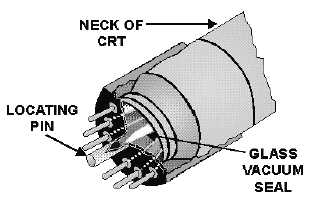2-31
Place the CRT face down in an empty carton and cover its side and back with protective material.
Carefully break off the plastic locating pin from the base (fig. 2-29) by crushing the locating pin
with a pair of pliers.
Figure 2-29.—Cathode-ray tube base structure.
Brush the broken plastic from the pin off the CRT base.
Look into the hole in the base where the locator pin was. You will see the glass extension of the
CRT called the vacuum seal. Grasp the vacuum seal near the end with the pliers and crush it.
This may sound a little risky but it isn’t. The vacuum seal can be crushed without shattering the tube.
Once the seal has been crushed, air will rush into the tube and eliminate the vacuum.
RADIOACTIVE ELECTRON TUBES
Another type of tube that can prove hazardous to you, if you handle it improperly, is the radioactive
tube.
These tubes contain radioactive material and are used as voltage-regulator, gas-switching, and cold-
cathode, gas-rectifier tubes. Some of these tubes have dangerous radioactive intensity levels. Radioactive
tubes are marked according to military specifications.
Radioactive material is added to a tube to aid in ionization. The radioactive material emits relatively
slowly moving particles. This should not worry you because the glass envelope is thick enough to keep
these particles inside the tube. Therefore, proper handling is nothing more than ensuring that the envelope
remains unbroken. If these tubes are broken and the radioactive material is exposed, or escapes from the
confines of the electron tube, the radioactive material becomes a potential hazard.
The concentration of radioactivity in an average collection of electron tubes in a maintenance shop
does not approach a dangerous level, and the hazards of injury from exposure are slight. However, at
major supply points, the storage of large quantities of radioactive electron tubes in a relatively small area
may create a hazard. For this reason, personnel working with equipment using electron tubes containing
radioactive material, or in areas where a large quantity of radioactive tubes are stored, should read and
become thoroughly familiar with the safety practices contained in Radiation, Health, and Protection
Manual, NAVMED P-5055. Strict compliance with the prescribed safety precautions and procedures of
this manual will help to prevent accidents, and to maintain a safe working environment which is
conducive to good health.

